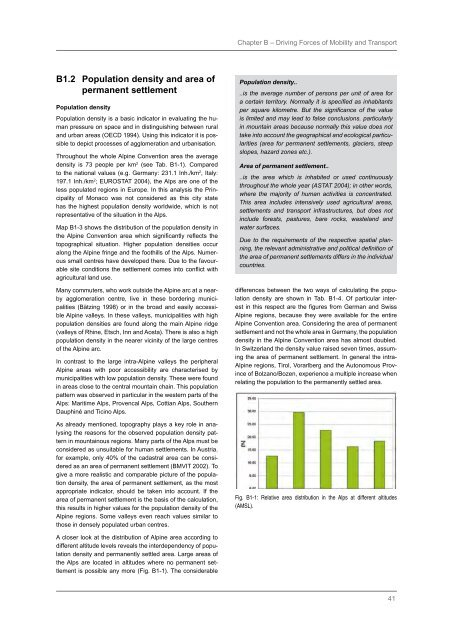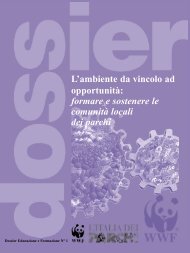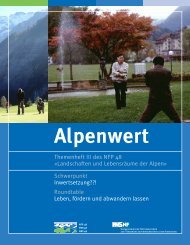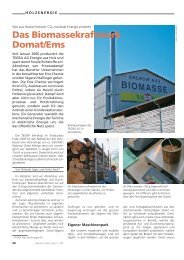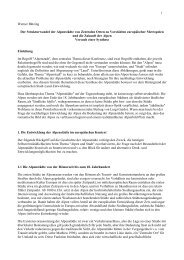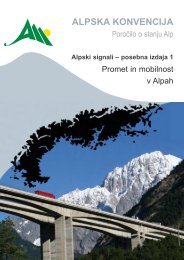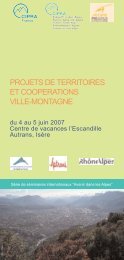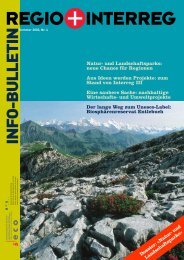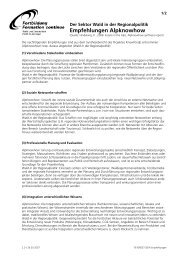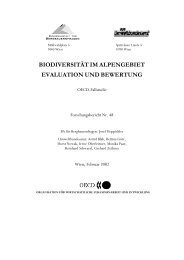English - Alps Know-How - Cipra
English - Alps Know-How - Cipra
English - Alps Know-How - Cipra
Create successful ePaper yourself
Turn your PDF publications into a flip-book with our unique Google optimized e-Paper software.
Chapter B – Driving Forces of Mobility and Transport<br />
B1.2 Population density and area of<br />
permanent settlement<br />
Population density<br />
Population density is a basic indicator in evaluating the human<br />
pressure on space and in distinguishing between rural<br />
and urban areas (OECD 1994). Using this indicator it is possible<br />
to depict processes of agglomeration and urbanisation.<br />
Throughout the whole Alpine Convention area the average<br />
density is 73 people per km 2 (see Tab. B1‐1). Compared<br />
to the national values (e.g. Germany: 231.1 Inh./km 2 , Italy:<br />
197.1 Inh./km 2 ; EUROSTAT 2004), the <strong>Alps</strong> are one of the<br />
less populated regions in Europe. In this analysis the Principality<br />
of Monaco was not considered as this city state<br />
has the highest population density worldwide, which is not<br />
representative of the situation in the <strong>Alps</strong>.<br />
Map B1‐3 shows the distribution of the population density in<br />
the Alpine Convention area which significantly reflects the<br />
topographical situation. Higher population densities occur<br />
along the Alpine fringe and the foothills of the <strong>Alps</strong>. Numerous<br />
small centres have developed there. Due to the favourable<br />
site conditions the settlement comes into conflict with<br />
agricultural land use.<br />
Many commuters, who work outside the Alpine arc at a nearby<br />
agglomeration centre, live in these bordering municipalities<br />
(Bätzing 1998) or in the broad and easily accessible<br />
Alpine valleys. In these valleys, municipalities with high<br />
population densities are found along the main Alpine ridge<br />
(valleys of Rhine, Etsch, Inn and Aosta). There is also a high<br />
population density in the nearer vicinity of the large centres<br />
of the Alpine arc.<br />
In contrast to the large intra-Alpine valleys the peripheral<br />
Alpine areas with poor accessibility are characterised by<br />
municipalities with low population density. These were found<br />
in areas close to the central mountain chain. This population<br />
pattern was observed in particular in the western parts of the<br />
<strong>Alps</strong>: Maritime <strong>Alps</strong>, Provencal <strong>Alps</strong>, Cottian <strong>Alps</strong>, Southern<br />
Dauphiné and Ticino <strong>Alps</strong>.<br />
As already mentioned, topography plays a key role in analysing<br />
the reasons for the observed population density pattern<br />
in mountainous regions. Many parts of the <strong>Alps</strong> must be<br />
considered as unsuitable for human settlements. In Austria,<br />
for example, only 40% of the cadastral area can be considered<br />
as an area of permanent settlement (BMVIT 2002). To<br />
give a more realistic and comparable picture of the population<br />
density, the area of permanent settlement, as the most<br />
appropriate indicator, should be taken into account. If the<br />
area of permanent settlement is the basis of the calculation,<br />
this results in higher values for the population density of the<br />
Alpine regions. Some valleys even reach values similar to<br />
those in densely populated urban centres.<br />
Population density..<br />
..is the average number of persons per unit of area for<br />
a certain territory. Normally it is specified as inhabitants<br />
per square kilometre. But the significance of the value<br />
is limited and may lead to false conclusions, particularly<br />
in mountain areas because normally this value does not<br />
take into account the geographical and ecological particularities<br />
(area for permanent settlements, glaciers, steep<br />
slopes, hazard zones etc.).<br />
Area of permanent settlement..<br />
..is the area which is inhabited or used continuously<br />
throughout the whole year (ASTAT 2004); in other words,<br />
where the majority of human activities is concentrated.<br />
This area includes intensively used agricultural areas,<br />
settlements and transport infrastructures, but does not<br />
include forests, pastures, bare rocks, wasteland and<br />
water surfaces.<br />
Due to the requirements of the respective spatial planning,<br />
the relevant administrative and political definition of<br />
the area of permanent settlements differs in the individual<br />
countries.<br />
differences between the two ways of calculating the population<br />
density are shown in Tab. B1‐4. Of particular interest<br />
in this respect are the figures from German and Swiss<br />
Alpine regions, because they were available for the entire<br />
Alpine Convention area. Considering the area of permanent<br />
settlement and not the whole area in Germany, the population<br />
density in the Alpine Convention area has almost doubled.<br />
In Switzerland the density value raised seven times, assuming<br />
the area of permanent settlement. In general the intra-<br />
Alpine regions, Tirol, Vorarlberg and the Autonomous Province<br />
of Bolzano/Bozen, experience a multiple increase when<br />
relating the population to the permanently settled area.<br />
Fig. B1‐1: Relative area distribution in the <strong>Alps</strong> at different altitudes<br />
(AMSL).<br />
A closer look at the distribution of Alpine area according to<br />
different altitude levels reveals the interdependency of population<br />
density and permanently settled area. Large areas of<br />
the <strong>Alps</strong> are located in altitudes where no permanent settlement<br />
is possible any more (Fig. B1‐1). The considerable<br />
41


